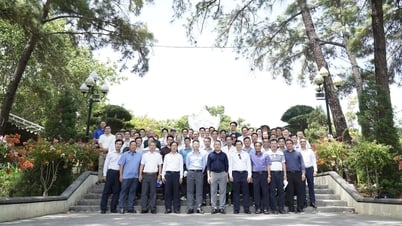In the draft, the Ministry of Finance proposed two options for adjusting the deduction level to submit to competent authorities for consideration.
Option 1, adjusted according to the CPI growth rate. Thus, the deduction for the taxpayer himself will increase from 11 million VND/month to about 13.3 million VND/month. The deduction for dependents will increase from 4.4 million VND/month to 5.3 million VND/month.
The Ministry of Finance assesses that this plan is in accordance with the current Personal Income Tax Law, ensuring basic living needs and inflation from the most recent adjustment time.
Option 2, adjusted according to the growth rate of per capita income and per capita GDP. Accordingly, the deduction for taxpayers is expected to increase to 15.5 million VND/month, and for dependents to 6.2 million VND/month.
The Ministry of Finance explained that this option will contribute to reducing tax obligations for taxpayers at a higher level. If implemented according to this option, the budget will reduce revenue, but when the family deduction level is higher, tax payments will decrease, and people's disposable income will increase. Thereby, this will contribute to stimulating increased household spending, social consumption, and indirectly help increase budget revenue from other sources in the medium and long term.
Thus, in both options proposed by the Ministry of Finance, the family deduction for taxpayers will increase by 2.3-4.5 million VND, and for dependents by 0.9-1.8 million VND per person per month compared to the present. It is expected that the new family deduction will be implemented from the time the resolution takes effect and will be applied from the 2026 tax period.

Assessing the adjustment of the family deduction level this time, Dr. Nguyen Ngoc Tu, a tax expert, said that the proposal to increase the family deduction level shows that the Ministry of Finance is open-minded and accepts the opinions of taxpayers, experts and ministries. Notably, this time the Ministry of Finance not only bases on the increase of CPI but also "leans" towards option 2 - which is more beneficial for taxpayers with income from wages and salaries when taking into account both the growth rate of GDP per capita and income per capita.
According to Dr. Nguyen Ngoc Tu, although Vietnam's highest tax rate of 35% is not high compared to other countries in the world , especially developed countries such as Sweden (56.6%), Denmark (55.4%), the Netherlands (52%), Australia, Belgium, the UK (50%), or Japan (50%), the gap between tax brackets of these countries is quite large, while in Vietnam, the tax rate schedule is too dense with short tax steps, causing pressure on taxpayers, especially those with low incomes because their income has just increased and they fall into a higher tax bracket.
“I think that even if the family deduction of VND15.5 million/month for taxpayers and VND6.2 million/month for dependents is still not really reasonable in the context of the high prices of essential goods and services over the past 5 years. This causes many difficulties for personal income taxpayers.
Therefore, the family deduction level may need to be raised to 17-18 million VND/month for the taxpayer himself and 8-9 million VND/month for dependents to ensure the welfare of the people. And this needs to be done this year instead of extending to next year," commented Dr. Nguyen Ngoc Tu.
Meanwhile, Ms. Nguyen Thi Cuc, President of the Tax Consulting Association, said that adjusting the family deduction for taxpayers from 11 million VND/month and dependents from 4.4 million VND/month to a suitable amount requires synchronous research on indicators of average GDP income, regional income level, essential spending needs for life, and price fluctuation index.
Along with that, it is necessary to study the combination of increasing the family deduction level with widening the gap between tax brackets, study the removal of the 35% tax rate, study tax reduction for some areas that need to be encouraged, attract high-quality human resources to ensure that people with different incomes are all reduced in tax regulation, ensuring horizontal and vertical equality of personal income tax.
Source: https://www.sggp.org.vn/nang-muc-giam-tru-gia-canh-cho-nguoi-nop-thue-viec-can-lam-ngay-post804930.html






































































































Comment (0)